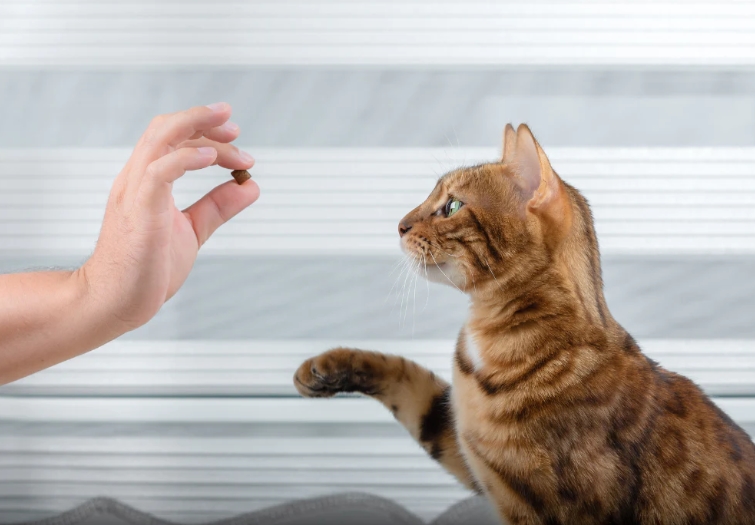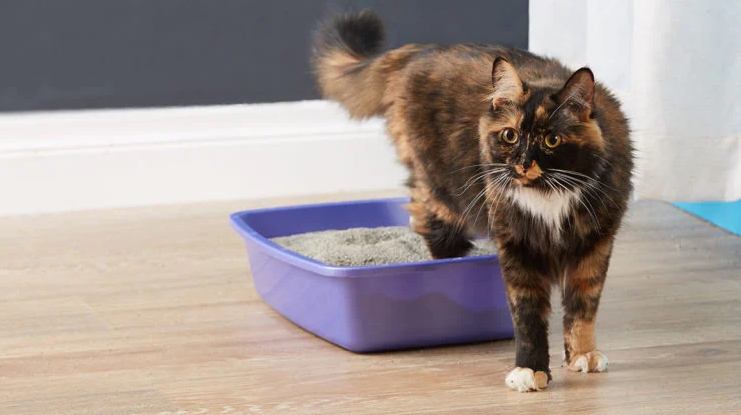Introduction: Train Your Cat in 5 Simple Steps
Key points:
- Why train your cat?
- What can you achieve through training?
Train Your Cat in 5 Simple Steps is not a myth. If you’re a cat owner, you may have heard that cats are independent and can’t be trained. However, the truth is that cats can learn a variety of behaviors and tricks with the right approach. Training your cat can be a rewarding experience for both you and your furry friend. In this beginner’s guide, we will show you 5 simple steps to train your cat effectively. From understanding your cat’s behavior to positive reinforcement techniques and basic commands, we’ll cover everything you need to know to get started with cat training. Whether you’re a first-time cat owner or simply looking to improve your cat’s behavior, this guide will provide you with the tools and knowledge to train your cat like a pro!
Step 1: Understanding your cat’s behavior
Key points:
- Basic feline instincts and behavior patterns
- How to read your cat’s body language
- Identifying your cat’s motivation and preferences
In training your cat is to understand their behavior. Cats have unique instincts and behavior patterns that are important to recognize if you want to train them effectively. For example, cats are natural hunters and have a strong desire to play and hunt. Understanding your cat’s motivation and preferences will help you identify what training methods will work best for them. Additionally, learning to read your cat’s body language can give you insight into its mood and reactions during training. Common body language signals include raised or flattened ears, tail movement, and vocalizations. By observing your cat’s behavior and responding appropriately, you can build a better relationship and establish trust with your furry friend. Overall, taking the time to understand your cat’s behavior is a crucial first step in successful cat training.
Step 2: Positive reinforcement training

Key points:
- What is positive reinforcement?
- Why it’s the most effective method for cat training
- Examples of positive reinforcement training techniques
In training your cat to use positive reinforcement. Positive reinforcement is a training method that rewards desired behaviors with treats, praise, or playtime. This method is much more effective than punishment or negative reinforcement, which can cause fear or aggression in your cat. When using positive reinforcement, it’s important to reward your cat immediately after they perform the desired behavior. This will help them associate the behavior with the reward. Start with simple behaviors, such as coming when called or sitting, and gradually increase the difficulty of the behavior. You can also use a clicker or a specific word to signal to your cat that they have performed the desired behavior correctly. With patience and consistency, your cat will learn to associate good behavior with positive outcomes and become a well-trained companion.
If you are planning to have a cat at your home, The Best Five Cat Breeds For Home
Step 3: Basic commands and tricks

Key points:
- Simple commands to teach your cat (e.g., “sit,” “come,” “stay”)
- Fun tricks to try with your cat (e.g., “high five,” “spin,” “fetch”)
In training your cat is to teach them basic commands and tricks. Basic commands like “come,” “sit,” and “stay” can help you control your cat’s behavior and keep them safe. To teach these commands, start by using treats and positive reinforcement to get your cat to associate the behavior with the reward. Once your cat has learned the basic commands, you can move on to teaching them tricks like “shake,” “high five,” or even “play dead.” Keep in mind that cats have shorter attention spans than dogs, so it’s best to keep training sessions short and frequent. Be patient and consistent with your training, and reward your cat for every step of progress. With time and practice, your cat will master basic commands and impress your friends with their new tricks!
Step 4: Problem-solving
Key points:
- Common cat behavior problems (e.g., scratching, biting)
- How to address and prevent these issues through training
In training your cat is to address any behavior problems through problem-solving. Cats can display a range of unwanted behaviors, such as scratching furniture, biting, or spraying. These behaviors can be frustrating for cat owners, but with the right approach, they can be addressed through training. The first step is to identify the root cause of the behavior. Is your cat scratching because they need to sharpen its claws, or are they marking its territory? Once you have identified the cause, you can start to address the behavior by redirecting it. For example, if your cat is scratching furniture, provide them with a scratching post or mat and reward them when they use it. If your cat is biting, teach them to play with toys instead of using your hands or feet as playthings. If your cat is spraying, consider spaying or neutering them to reduce territorial behavior. Remember to always use positive reinforcement when training, and never punish your cat for unwanted behavior. With patience and persistence, you can solve any behavior problems and enjoy a harmonious relationship with your furry friend.
Save your cat, before it’s too late Common Cat Diseases and Symptoms
Step 5: Advanced training techniques
Key points:
- Building on basic training to teach more complex behaviors
- Examples of advanced training techniques (e.g., agility training, leash training)
In training your cat is to explore advanced training techniques. Once your cat has mastered basic commands and behavior problems have been addressed, you can move on to more advanced training. One technique is agility training, which involves teaching your cat to navigate through obstacles like tunnels and jumps. This can be a fun way to stimulate your cat’s mind and body while building their confidence. Another technique is clicker training, which uses a clicking sound to signal to your cat that they have performed the desired behavior correctly. Clicker training can be used to teach more complex behaviors like fetching or rolling over. It’s important to keep training sessions short and fun and to always use positive reinforcement. Additionally, training your cat to walk on a leash can provide a new way to explore the world together. This can take time and patience, but with practice and rewards, your cat can become comfortable walking on a leash. Remember to always tailor your training to your cat’s personality and preferences, and to celebrate their progress along the way. Advanced training can be a fun way to bond with your cat and help them reach its full potential.
Final Note: Train Your Cat in 5 Simple Steps
Key points:
- Recap of the five steps to training your cat
- Final tips for successful cat training.
In conclusion, training your cat can be a rewarding and fulfilling experience for both you and your furry friend. By following these five simple steps, you can teach your cat basic commands, address any behavior problems, and explore advanced training techniques. Remember to use positive reinforcement, keep training sessions short and frequent, and tailor your approach to your cat’s personality and preferences. With patience and persistence, your cat can become a well-behaved and happy companion. Training your cat can also strengthen your bond and create a deeper understanding of each other. So why not start today? With these tips, you can embark on a journey of training your cat and creating a lifelong relationship full of love and respect.
The advantages of Training Your Cat

Training your cat can have many advantages for both you and your furry friend. By teaching your cat acceptable behavior, strengthening your bond, providing mental stimulation, improving safety, making vet visits easier, promoting better health, and improving communication, training can help create a happier and healthier relationship between you and your feline companion. In this article, we will discuss each of these advantages in more detail, so you can better understand the benefits of training your cat.
Better Behavior
One of the most significant benefits of training your cat is that you can teach them acceptable behavior. This means that your cat is less likely to engage in undesirable behavior, such as scratching furniture, jumping on counters, or urinating outside of their litter box.
Training your cat can help them understand what is expected of them, which can lead to fewer behavioral issues. By providing your cat with positive reinforcement for good behavior, you can help them develop habits that are more conducive to a happy and harmonious home. Do you know How to Train Your Family Pet for a Happier Home?
Strengthened Bond
Training your cat can also help to strengthen the bond between you and your furry friend. Spending time training your cat can help build trust between the two of you, as your cat learns to rely on you for guidance and support.
Training your cat can also help them become more comfortable around you, which can lead to a stronger bond. When your cat trusts you, they are more likely to seek out your attention and affection, which can lead to a more rewarding relationship for both of you.
Mental Stimulation
Cats need mental stimulation just as much as physical exercise. Training your cat can provide them with the mental challenge they need, which can help prevent boredom and depression.
When your cat is mentally stimulated, they are more likely to be engaged and happy. This can lead to fewer behavior problems, as your cat is less likely to engage in destructive behavior due to boredom or frustration.
Safety
Training your cat can also help keep them safe. By teaching your cat to come when called, stay in certain areas, or avoid dangerous situations, you can help prevent accidents or injuries.
This is especially important if your cat is an indoor/outdoor cat or if you have other pets in the home. By teaching your cat to behave appropriately around other animals, you can help prevent fights or injuries.
Easier Vet Visits
Training your cat can also make vet visits less stressful for both you and your cat. When your cat is trained, they are more likely to tolerate being handled, examined, and treated by the veterinarian.
This can make vet visits less stressful for you, as you don’t have to worry about your cat becoming aggressive or scared. It can also make vet visits less stressful for your cat, as they are more likely to be relaxed and comfortable during the appointment.
Improved Health
Training your cat can also lead to improved health. When your cat is trained to engage in regular exercise and play, they are more likely to maintain a healthy weight and stay active.
Training your cat to use a scratching post instead of your furniture can also help prevent injuries and infections. In addition, training your cat to use a litter box can help prevent urinary tract infections and other health issues.
Better Communication
Finally, training your cat can help improve communication between you and your furry friend. By teaching your cat to respond to certain cues or commands, you can communicate your expectations more effectively.
This can lead to fewer misunderstandings between you and your cat, which can help strengthen your bond and lead to a more harmonious relationship.
In conclusion, training your cat can have many benefits. From better behavior to improved health, training can help you and your furry friend enjoy a happier, healthier, and more harmonious life together. we can recommend if you need more info about Cat – Wikipedia.
We hope our article helps you to understand your pet cat a little bit better than before. Share your opinions, and keep in touch. Thanks for visiting us.
